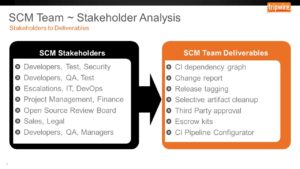It’s been a few months since I presented on continuous integration configuration and other automation principles at SwampUp 2017 in Napa, CA. Now that I’ve had time to reflect on feedback from both attendees and online viewers, I have discovered one important concept was missing from the presentation. I will call it the missing slide and present it here.
The concept I missed was tying the seven automation projects back to the stakeholders who benefited; an easy slide to omit since the entire reason for this blog is my passion for shifting my industry away from the very prevalent, “fight for my favorite tools” approach to selecting technology – a common occurrence in software configuration management and DevOps. I wasn’t there to present software configuration management basics, so the oversight is due the fact that I advocate for a principle of “stakeholder analysis” when designing configuration management systems. I consider this on of the most basic SCM principles and should have included it even though I was focused on presenting the advanced concepts like self-configuring pipelines. Here is the missing slide:
As you can see, a wide variety of stakeholders benefit from the automation projects I talked about in the presentation. Here are some stakeholder needs met by this project.
- Development teams understand the impact of changes to specific modules.
- Escalation teams are able to build and test hot fixes for customer defects.
- Third party, open source library review boards know which dependencies are being changed.
- QA and test teams understand component changes for regression test planning.
- Artifact repository administrators are able to trash artifacts without removing the important ones.
- Legal team knows escrow requirements have been met.
- Developers know builds are triggering correctly.
The list goes on, but you get the idea.
My specific solution may not be right for your organization, but I hope you can learn from it. If your stakeholders differ from mine, you will need to adjust accordingly. A prepackaged software development organization has different requirements from a hosted service organization and is different from a retailer maintain a customer website. There are a lot of stakeholders in my world.
Who are the stakeholders your team serves?
